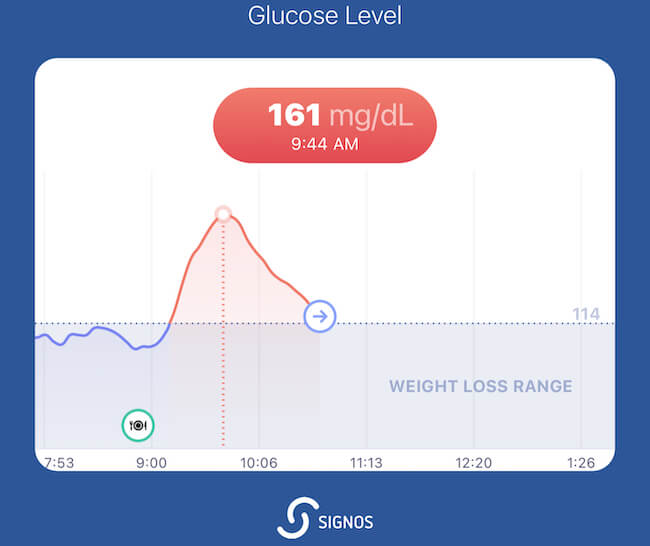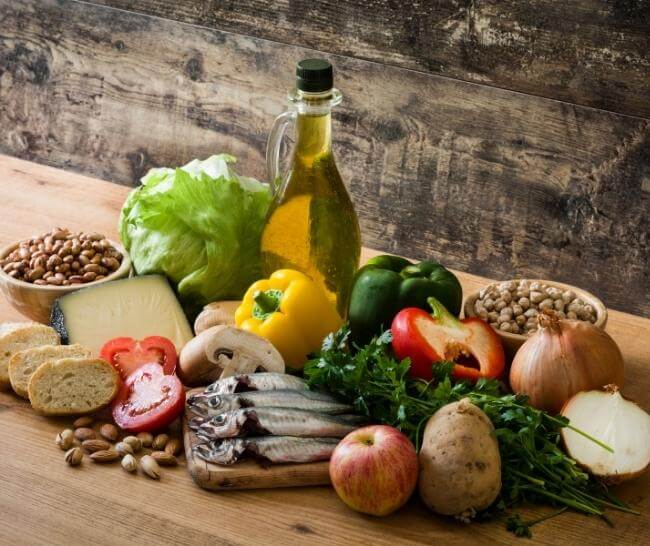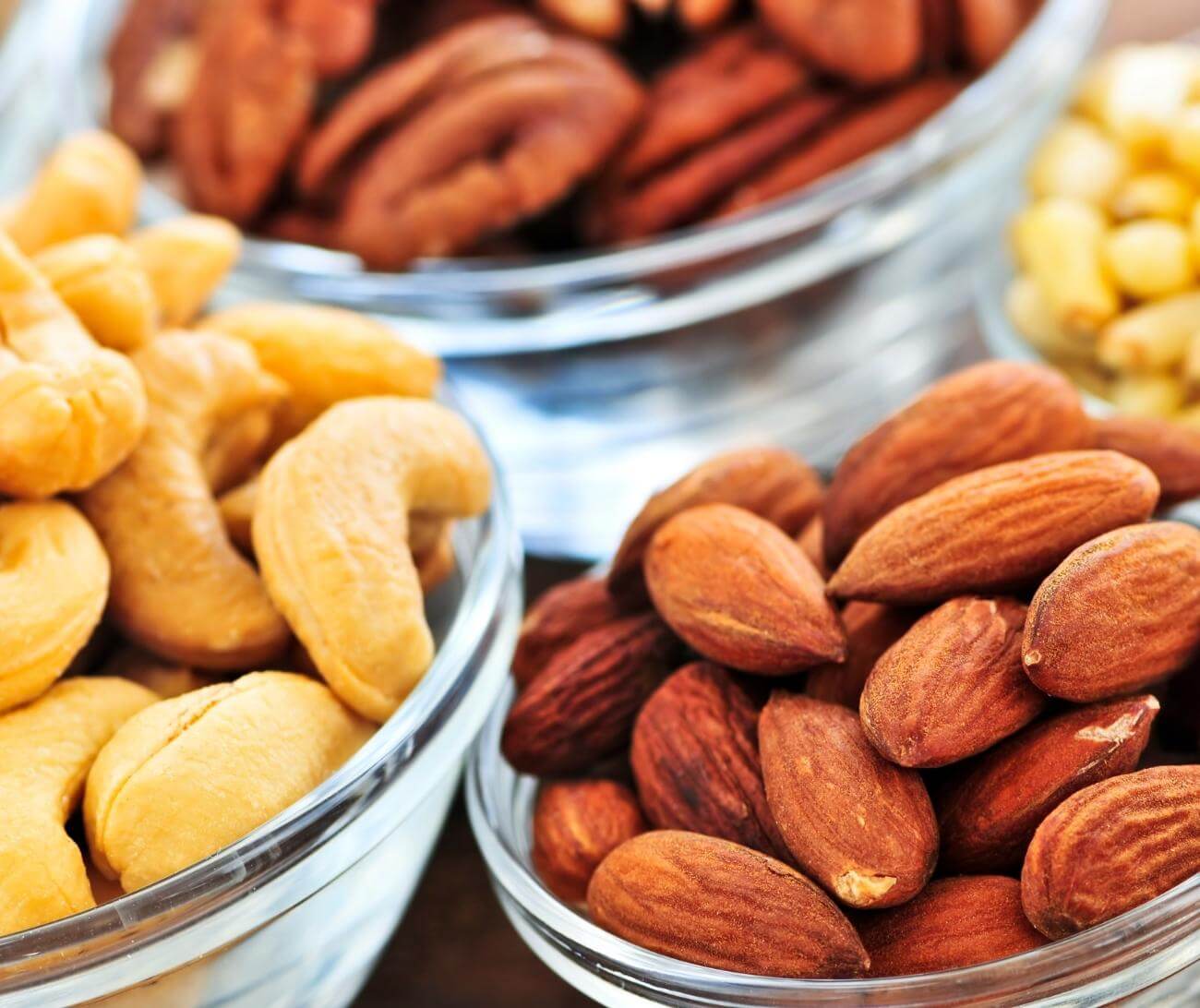What you'll learn in this article about food and blood sugar:
- Everyone’s response to foods can be different, but there are certain foods that can help most people achieve and maintain stable blood sugar.
- Eat foods that are high in fiber, protein, and healthful fats to stabilize your blood sugar.
- Use a continuous glucose monitor and the Signos app to get real-time feedback on your glucose response.
People who don’t have diabetes still need to achieve and maintain stable blood sugar levels for optimal health. A nutrient-dense diet that supports stable blood glucose levels helps you avoid any potential unpleasant symptoms associated with blood sugar spikes (such as fatigue, thirst, and blurred vision)<sup>1</sup> and crashes (such as rapid heart rate, shaking, dizziness, and hunger)<sup>2</sup>. Your blood sugar would need to spike pretty high to feel these effects—if you drank a lot of orange juice on an empty stomach, for example—but for favorable metabolic health, it’s important to avoid these high spikes and crashes.
While everyone’s glucose response to foods and drinks can differ and may be impacted by other factors (such as exercise, sleep, stress, illness, etc.), there are certain foods and food combinations that tend to work for all to keep blood sugar stable.
<p class="pro-tip">Read more: There are only a few essential lifestyle changes needed to better stabilize your blood sugar. See the How to Reap the Benefits of Stable Glucose</p>
Characteristics of Glucose-stabilizing Foods
The best foods for stable blood sugar tend to have a few characteristics in common: high fiber, high protein, and healthful fats.
High Fiber
High-fiber foods, especially from plants, are often suggested as solutions to glucose instability. One research review showed that dietary soluble fibers are associated with improved blood glucose control<sup>3</sup>. Soluble fiber also reduces the increase in blood sugar after a meal<sup>4</sup>.
In 2015, the Academy of Nutrition and Dietetics emphasized the importance of getting enough dietary fiber from plant sources, citing evidence that dietary fiber reduces the risk of type 2 diabetes and other diseases and slows down glucose absorption. As opposed to fiber supplements, eating a variety of naturally high-fiber foods, such as whole grains, fruits, and vegetables, maximizes the nutritional value you receive. High-fiber diets<sup>5</sup> also tend to be: “lower in saturated and trans-fatty acids, sodium, and added sugars,” all qualities of an overall healthy diet.
High Protein
High-protein foods similarly result in more stable blood sugar. One study of 14 healthy women analyzed the blood sugar effects of high-protein, low-carb foods that are also ultra low processed. Researchers concluded that these high-protein foods cause a significantly lower glycemic response<sup>6</sup>, making them useful for both weight control and diabetes management.
Before you start guzzling protein shakes, too much protein won’t serve your body composition goals. While research shows support for the positive postprandial effects of a high-protein meal, ingesting more than about 20–30 grams<sup>7</sup> at one time doesn’t prove more beneficial for increasing fat-free mass.
Healthful Fats
Healthful fats are essential nutrients. Mediterranean diets are well known for including many healthful fats, such as olive oil, olives, nuts and seeds, and emphasize fruit, vegetables, legume, fish and seafood consumption.
One 2017 study of 7,447 people on a Mediterranean diet supplemented with either extra-virgin olive oil or mixed nuts, versus a reduced-fat control diet found that the Mediterranean diets lowered fasting blood glucose and reduced the risk of diabetes<sup>8</sup>.
<p class="pro-tip">Learn more about the Mediterranean diet and blood sugar</p>
Another study of 89 overweight men and women suggested that following a combined ketogenic Mediterranean diet resulted not only in weight loss and maintenance<sup>9</sup> but also significantly reduced glucose levels.
{{mid-cta}}
List of Foods that Help Stabilize Blood Sugar
Now that we know the broad qualities of foods that keep your blood sugar stable, let’s look at what foods to add to your diet. Many fruits and vegetables contain soluble dietary fiber, which leads to improved glucose control<sup>10</sup>. You’ll notice a great deal of these on this list!
Leafy Greens
At the top of the list of foods to help stabilize your blood sugar: leafy greens. Try spinach, kale, collard greens, dandelion greens, bok choy, lettuce, and Swiss chard. Leafy greens contain a lot of fiber as well as antioxidants and micronutrients. For example, spinach contains nutrients that lower blood sugar<sup>11</sup>.
Cruciferous Vegetables
Cruciferous vegetables include broccoli, cauliflower, cabbage, Brussels sprouts, and other vegetables that grow with four petals resembling a cross.
Broccoli contains complex carbohydrates, which increase blood sugar much more slowly than simple carbohydrates found in white bread or soda. Broccoli also contains soluble fiber<sup>12</sup>, discussed earlier.
One study suggests that eating cooked broccoli with mashed potatoes improves glucose regulation and significantly affects glycemic response<sup>13</sup> compared to potatoes eaten alone. This strategy can help you avoid a blood sugar spike but you still get to enjoy creamy, carb-y mashed potatoes.
<p class="pro-tip"><strong>Learn More About </strong> <a href=how-potatoes-affect-blood-sugar>How Potatoes Affect Blood Sugar</a>.</p>
Whole Grains
Whole grains that can help stabilize your blood sugar include barley, oats, and quinoa. Unrefined whole grains contain complex carbohydrates and, like broccoli, gradually increase blood sugar rather than causing a sudden spike.
Lower-glycemic Fruits
Many kinds of fruits and berries contain important nutrients for stabilizing blood sugar. Flavonoids, found in a variety of fruits, regulate glucose metabolism<sup>14</sup> in the liver. Passion fruit also contains ascorbic acid, which reduces blood sugar<sup>15</sup>.
Other low-glycemic fruits and berries that are good for your blood sugar include pomegranates, raspberries, and blackberries.
<p class="pro-tip">Read more: Did you know Your Blood Sugar Level Can Be Higher in the Morning?</p>
Nuts & Seeds
Many nuts provide necessary and healthful fats, fiber, and protein—all qualities of blood-sugar stabilizing foods. Nuts have a low glycemic index because of their high fat, moderate protein, and lower carbohydrate content. They are especially beneficial in lowering the risk of a variety of diseases<sup>16</sup>, including cardiovascular disease and cancer.
Seeds can also help control and lower blood glucose levels<sup>17</sup>. For example, the seeds of certain gourds (such as pumpkins and squash) have significant blood sugar-reducing qualities<sup>18</sup>. One study found pumpkin seeds to reduce blood sugar spikes after meals<sup>19</sup>. Similarly, flaxseed can also help manage metabolic syndrome to better control fasting blood sugar<sup>20</sup>.
<p class="pro-tip">Read more about the best nuts for blood sugar</p>
Avocado
Avocados contain very little sugar compared to other fruits, and some studies suggest the main type of sugar they contain may support blood glucose control and weight management<sup>21</sup>. Since avocados are full of healthful fats, enjoy organic guacamole with jicama or carrot sticks and mashed avocado on top of sprouted whole-grain toast.
Fatty Fish & Seafood
Fatty (or oily) fish—such as tuna, salmon, sardines, herring, mackerel, halibut, and trout—along with other seafood, make excellent additions to a blood sugar-stabilizing diet<sup>22</sup>. One study demonstrated that fatty fish improved glucose regulation in overweight or obese adults, while lean fish, such as cod, did not affect glucose regulation<sup>23</sup>.
<p class="pro-tip">Read More: Believe it or not, there are actually numerous ways to get your blood sugar down quickly. See 11 Ways to Lower Blood Sugar Fast</p>
Foods to Avoid
Integrating the foods above into your diet may significantly improve your glucose response. Removing or limiting certain other foods from your diet will also help you maintain stable blood sugar levels.
Foods that tend to spike your blood sugar include sugary beverages<sup>24</sup>, high-glycemic foods like white bread and pasta<sup>25</sup> and foods with added sugars, such as flavored yogurt or sweetened cereal.
<p class="pro-tip">Read more: Managing blood sugar requires a few key food tips. See How to Follow a Low-Glycemic Diet</p>
FAQs
What is a stable blood sugar level?
Your stable blood sugar level may vary depending on your age, overall health, and other factors. In general, for diabetics, blood sugar before a meal should be between 80 and 130 mg/dL. Two hours after starting to eat a meal, a diabetic’s blood sugar should be below 180 mg/dL<sup>26</sup>.
For non-diabetics, your before-meal blood sugar should fall in between about 72 to 100 mg/dL. Post-meal blood sugar for non-diabetics one to two hours after eating should be around 140 mg/dL or less.
What causes low blood sugar (hypoglycemia)?
Low blood sugar, typically below 70 mg/dL in non-diabetics, may be caused by skipping meals, strenuous exercise, drinking alcohol, or other factors. It’s important to note that hypoglycemia is extremely rare in non-diabetics who don’t take insulin.
What causes high blood sugar (hyperglycemia)?
High blood sugar (over 240 mg/dL) may be caused by illness, stress, overeating, or other factors.
How else can I maintain stable blood sugar?
In addition to the healthy dietary recommendations above, diabetics and non-diabetics can manage blood sugar by exercising regularly, tracking your blood sugar to see what affects it, eating when genuinely hungry (clue: your fasting glucose can be a great metric to review to help you learn more about recognizing signs of true hunger), tracking your diet and exercise habits, drinking water instead of sugary beverages, limiting alcohol, eating fruits rather than sweets, and controlling food portions.
<p class="pro-tip">Read these tips to control blood sugar spikes after meals and learn which factors can affect blood sugar.</p>
Using Signos to Monitor & Control Blood Sugar Spikes
Everyone’s body is different and reacts to foods and nutrients a little differently. As you begin to implement these dietary suggestions, you can find out how specific foods affect your blood sugar by tracking your glucose response using Signos.
Signos uses a CGM to gather your biodata and provides real-time feedback on how your body responds to different foods. The Signos app then suggests small changes in your activities or eating habits to reduce glucose spikes.
<p class="pro-tip">Read more: Diabetics aren’t the only group of people who need to check their blood sugar. Here’s What Your Blood Sugar Should Be at Bedtime</p>
- Item 1
- Item 2
- item 3
Topics discussed in this article:
References
1. https://www.cdc.gov/diabetes/managing/manage-blood-sugar.html
2. https://www.cdc.gov/diabetes/basics/low-blood-sugar.html
3. https://link.springer.com/article/10.1007%2Fs11883-016-0624-z
4. https://www.ncbi.nlm.nih.gov/books/NBK459280/
5. https://www.jandonline.org/article/S2212-2672(15)01386-6/fulltext
6. https://pubmed.ncbi.nlm.nih.gov/27754766/
7. https://www.frontiersin.org/articles/10.3389/fendo.2018.00443/full
8. https://www.ncbi.nlm.nih.gov/pmc/articles/PMC5577766/
9. https://www.ncbi.nlm.nih.gov/pmc/articles/PMC3875914/
10. https://www.tandfonline.com/doi/full/10.1080/10408398.2019.1632258
11. https://pubmed.ncbi.nlm.nih.gov/27353735/
12. https://www.ncbi.nlm.nih.gov/books/NBK459280/
13. https://pubmed.ncbi.nlm.nih.gov/27655525/
14. https://www.ncbi.nlm.nih.gov/pmc/articles/PMC6769509/
15. https://www.ncbi.nlm.nih.gov/pmc/articles/PMC6779082/
16. https://pubmed.ncbi.nlm.nih.gov/32006366/
17. https://pubmed.ncbi.nlm.nih.gov/32006367/
18. https://www.ncbi.nlm.nih.gov/pmc/articles/PMC3618205/
19. https://pubmed.ncbi.nlm.nih.gov/30055778/
20. https://pubmed.ncbi.nlm.nih.gov/32436825/
21. https://www.ncbi.nlm.nih.gov/pmc/articles/PMC3664913/
22. https://pubmed.ncbi.nlm.nih.gov/28606215/
24. https://www.ncbi.nlm.nih.gov/pmc/articles/PMC2673878/
25. https://care.diabetesjournals.org/content/27/9/2266.long
26. https://www.cdc.gov/diabetes/managing/manage-blood-sugar.html
































